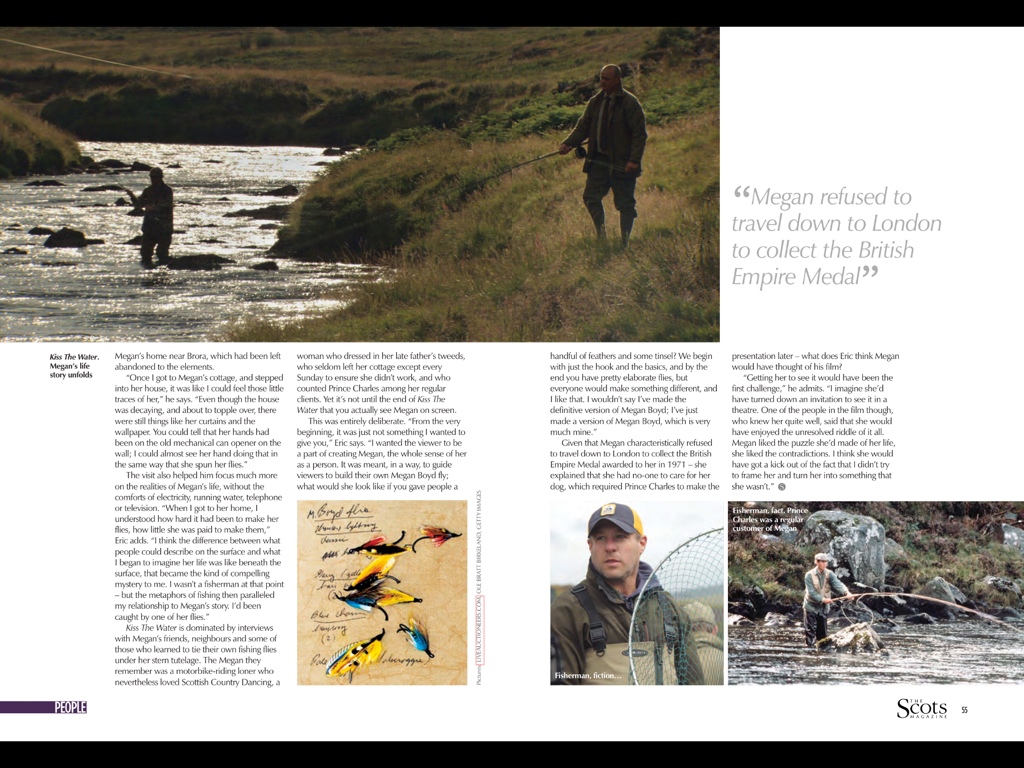 A new documentary film explores the life of Megan Boyd who, when she died aged 86, was famous in the fishing world for creating exquisite flies that bagged some of the biggest salmon ever caught—and even a Prince!
A new documentary film explores the life of Megan Boyd who, when she died aged 86, was famous in the fishing world for creating exquisite flies that bagged some of the biggest salmon ever caught—and even a Prince!
by Paul F Cockburn.
Filmmaker Eric Steel never met Megan Boyd. Indeed, he only first learned about her after her death in 2001, when he read her obituary in the New York Times–itself a sign of her international standing, at least within the world of salmon fishing. Her flies were described “the Tiffanies of the 20th century” by no less than the American Fly Fisher magazine.
“I worked in the movie business, but I hadn’t made a film yet. I wasn’t even thinking of it as a movie,” Eric admits. “My understanding of the obituary, of the words, was so much about the romance and fairytale, a kind of romanticised version of this life. I must have stared at this clipping on my wall for almost 10 years; there were parts of it I could recite by heart.”
It would be almost a decade, however, before Eric began to work on what would become Kiss The Water. “It was a combination of different things; my father had passed away in 2009, and that got me thinking a lot about what traces people leave behind, and the relationship between stories and truth. Also, I was spending a lot of time out on the east end of Long Island, staring out into the Atlantic and reflecting on the water, and something about that made me think of Megan in her little cottage staring out to sea.”
On his first trip to Scotland, Eric visited Megan’s home, which had been left abandoned to the elements. “Once I got to Megan’s cottage, and stepped into her house, it was like I could feel those little traces of her,” he says. “Even though the house was decaying, and about to topple over, there were still things like her curtains and the wallpaper. You could tell that her hands had been on the old mechanical can opener on the wall; I could almost see her hand doing that in the same way that she spun her flies.”
The visit also helped him focus much more on the realities of Megan’s life, without the comforts of electricity, running water, telephone or television. “When I got to her home, I understood more how hard it was to make her flies, how little she was paid to make them,” Craig adds. “I think the difference between what people could describe on the surface and what I began to imagine her life was like beneath the surface, that became the kind of compelling mystery to me. I wasn’t a fisherman at that point–but the metaphors of fishing then paralleled my relationship to Megan’s story. I’d been caught by one of her flies.”
Kiss The Water is dominated by interviews with Megan’s friends, neighbours and some of those who learned to tie their own fishing flies under her stern tutelage. The Megan they remember is of a motor-bike riding loner who nevertheless loved Scottish Country Dancing, a woman who dressed in her late father’s tweeds, who seldom left her cottage except every Sunday to ensure she didn’t work, and who counted Prince Charles among her regular ‘clients’. Yet it’s not until the end of Kiss The Water that you actually see Megan on screen.
This was entirely deliberate. “From the very beginning, it was just not something I wanted to give you,” Eric says. “I wanted the viewer to be a part of creating Megan, the whole sense of her as a person. It was meant, in a way, to guide viewers to build their own Megan Boyd fly; what would she look like if you gave people a handful of feathers and some tinsel? We begin with just the hook and the basics, and by the end you have pretty elaborate flies, but everyone would make something different, and I like that. I wouldn’t say I’ve made the definitive version of Megan Boyd; I’ve just made a version of Megan Boyd, which is very much mine.”
Given that Megan characteristically refused to travel down to London to collect the British Empire Medical awarded to her in 1971–she explained that she had no one to care for her dog, which required Prince Charles to make the presentation later–what does Eric think Megan would have thought of his film?
“Getting her to see it would have been the first challenge,” he admits. “I imagine she’d have turned down an invitation to see it in a theatre. One of the people in the film though, who knew her quite well, said that she would have enjoyed the unresolved riddle of it all. Megan liked the puzzle she’d made of her life, she liked the contradictions. I think she would have got a kick out of the fact that I didn’t try to frame her and turn her into something that she wasn’t.”
First published by The Scots Magazine (October 2013).